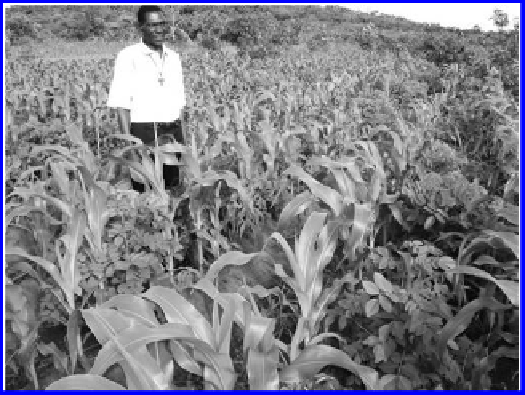Agriculture Reference
In-Depth Information
11.1.1 A
fricAn
S
mAllholderS
, S
oil
m
AnAgement
,
And
f
ood
S
ecurity
Africa is the only region in the world where the per capita food production has been
consistently falling (Payne 2010, p. 45). While the number and prevalence of the
undernourished has declined worldwide since 1990, in sub-Saharan Africa the num-
ber of undernourished has increased from 175 million to 239 million people (Food
and Agriculture Organization of the United Nations, World Food Programme, and
International Fund for Agricultural Development 2012). Impoverished populations
in Africa remain concentrated in rural areas. The United Nations Environment
Program (2009) estimated that 80% of the most desperately poor in Africa are sub-
sistence farmers. According to the World Bank (2008), the majority of the poor are
expected to remain in rural areas until at least 2040.
Soil and water resources worldwide are under stress from the accelerated
demands of increasing population (Lal 2010). These stresses are of great concern
in Africa because the rural poor rely most on these soil and water resources. Many
smallholder farmers in Africa are located in areas where rainfall is low, erratic, and
unreliable. Rainfall variability is a major challenge as many smallholder agricultural
systems of eastern and southern Africa are predominantly rainfed and irrigation
systems are not well developed (Camberlin et al. 2009). Most smallholder farm-
ers in Africa practice low-input subsistence farming based on fertility-mining and
extractive practices in which output exceeds input (Lal 2007). As yields decrease,
the pressure to cultivate marginal lands increases. Deforestation and land degrada-
tion accompanying agricultural expansion have fragmented ecosystem provisioning,
regulating, and supporting services previously provided by woodlands. Sustainable
intensification (Figure 11.1) of agricultural systems in sub-Saharan Africa is the key
to reducing food insecurity (Garrity et al. 2010; Payne 2010, p. 45). Agroforestry is
FIGURE 11.1
Mr. Mariko Majoni demonstrates his
Gliricidia sepium
-maize intercrop near
Chiradzulu, Malawi. (From ICRAF.)

